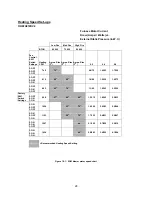
13
e. Select values for the pressure drops of both the supply and return air systems. Each branch
of the supply (or the return) air system will have this pressure drop. The total pressure drop of
the supply and return air systems added together cannot exceed the maximum external static
pressure that can be supplied by the appliance blower.
f. Determine the required flow rate for each branch of the supply and return air systems. The
total airflow rate, by adding the airflow rate of each branch of the supply system, must equal
the minimum required airflow rate (refer to part 3, above). Likewise, the airflow rate of each of
the branches of the return air system must sum to the required minimum flow rate.
g. Using the selected air flow rates for each component of the duct system and manufacturer’s
literature, or published literature on duct system pressure drops, the pressure drop for each
component in the duct system can be estimated.
The ASHRAE Handbook – Fundamentals is an excellent source of duct system design principles
and pressure drop data. Conversely, for a specified type of fitting, it is also possible to determine
the required size or diameter of the component for a specified pressure drop and flow rate.
h. The resistance of the take-off and the outlet register (or return grill) should then be summed
together to determine the total pressure drop for each branch. This value should be close to
the assumed value for the pressure drop of the system. If it is not close, then flow rates for
each branch must be adjusted, or the design of the duct system must be altered, to give the
proper pressure drops. Usually, the cross-sectional area of the ductwork should be changed
in order to adjust the pressure drop to a suitable value. Refer to Example 2, (page 14) for a
sample calculation of how to use
this method for sizing the supply side ductwork for a
residence.
Table 3 shows the air handling capacities of 100-ft. lengths of circular and rectangular
ductwork based on a 0.1 in. W.G. static pressure drop. The first column to the right is the
airflow rate and the second is the required diameter for a circular duct. The third column is
the required cross-sectional area of the duct and the other columns to the left are rectangular
ducts with sufficient cross-sectional area to handle the flow at the specified pressure drop.
[For lengths of ductwork less than 100 ft., simply multiply 0.1 in. W.G. by the ratio of the
actual duct length (in feet) over 100 ft. for the approximate pressure drop.] Use the supplier’s
catalog for proper sizing of outlet air registers and return air grills to insure that they provide
the required flow rate at the desired pressure drop.
Summary of Contents for OH6FA072D48N
Page 5: ...2...
Page 33: ...30 Heating Speed Set ups 2 Stage OH6FX072DV4 Figure 18 2 ECM 2 stage blower motor speed chart...
Page 64: ...61 VIII Sequence of Operations Flow Chart...
Page 65: ...62...
Page 66: ...63 IX Trouble Shooting Flow Chart...
Page 67: ...64...
Page 68: ...65...
Page 69: ...66...
Page 70: ...67...
Page 72: ...69 Appendix A Replacement Parts Replacement Parts for OH6FA072D...
Page 73: ...70 Replacement Parts for OH8FA119D...
Page 74: ...71 Appendix B Wiring Diagrams OH6FA072D48 PSC Wiring Diagram...
Page 75: ...72 OH6FA072DV4 ECM Wiring Diagram...
Page 76: ...73 OH6FX072DV4 ECM 2 Stage Wiring Diagram...
Page 77: ...74 OH8FA1119D60 PSC Wiring Diagram...
Page 78: ...75 OH8FA1119DV5 ECM Wiring Diagram...
Page 79: ...76...










































